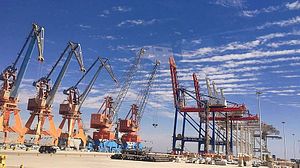By Mercy A. Kuo
Trans-Pacific View author Mercy Kuo regularly engages subject-matter experts, policy practitioners, and strategic thinkers across the globe for their diverse insights into U.S. Asia policy. This conversation with Matthew P. Goodman – Senior Vice President in charge of Asian economics at the Center for Strategic and International Studies (CSIS), who served twice at the White House on the National Security Council staff – is the 231st in “The Trans-Pacific View Insight Series”.
Explain the rationale and role of the Blue Dot Network (BDN).
As my colleagues and I discussed in a recent CSIS piece, the BDN was announced by the United States, Japan, and Australia in November 2019 at the Indo-Pacific Business Forum in Thailand. Together, the three allies plan to certify infrastructure projects around the world that meet high standards of transparency, sustainability, and developmental impact. The aim is to give private investors – including U.S. pension funds and insurance companies, which together manage trillions of dollars of long-term assets – the confidence to jump in and help address the massive global need for infrastructure, estimated at $94 trillion over the next two decades.
The BDN is a promising idea, but there are a number of practical questions – about the certification system, about funding, about the incentives for recipient countries to pay a bit more and wait a bit longer to get needed infrastructure – that need to be answered before this initiative takes off.
Explain the function of the U.S. International Development Finance Corporation (DFC) and its Japanese and Australian counterparts in leading BDN and whether other countries will be included in BDN.
The DFC was created by Congress last year to replace the U.S. Overseas Private Investment Corporation (OPIC) as the official development finance institution of the United States. Among other major changes, DFC has twice the financial firepower of OPIC, with an ability to invest up to $60 billion; it can take equity positions in investments, not just lend; and it has an expanded mission to support U.S. foreign policy objectives as well as international development. In these regards, the new DFC looks more like its Japanese and Australian counterparts – the Japan Bank for International Cooperation (JBIC) and the development finance arm of Australia’s Department of Foreign Affairs and Trade (DFAT).
The three governments have said that no country is excluded from the BDN if they support the mission of promoting high-quality, private-sector-led investment. No other countries have officially joined the Network yet, but discussions are reportedly being held with the European Union and others. It is worth noting that leaders from the Group of 20 major economies (G-20), which includes China, India, and others, endorsed a set of principles for quality infrastructure investment at their meeting in Osaka last year, so a wide array of countries might be interested in joining if the initiative gets off the ground.
Compare and contrast project financing facilities of the BDN and China’s Belt and Road Initiative (BRI).
A comparison of the financing facilities is very difficult. For one thing, very little is known about the financing terms of BRI projects. The lending practices of Chinese policy banks like the China Development Bank and China Export-Import Bank are notoriously opaque, even to other Chinese government agencies. On the BDN side of the equation, the initiative hasn’t been fully fleshed out yet, and project financing facilities are among the many details that have to be clarified. Presumably these will broadly align with the current policies of JBIC, DFAT, and the new DFC. But again, the latter just started operations and has yet to find its “sea legs” as a lending institution.
Assess BDN’s effectiveness as a geopolitical mechanism to counter China’s BRI.
The three governments have been at pains to say that the BDN is not a response to China’s Belt and Road Initiative. However, cynics have argued that the choice of “blue” in the initiative’s name was not an accident: a clear contrast to the “red” of BRI. As we said in our recent CSIS commentary, the United States and its allies cannot and should not try to compete with China over every infrastructure project in the world. Washington will never spend the kind of money that Beijing says it intends to through BRI. But the United States also has a commercial and strategic interest in promoting infrastructure around the world, and it brings unique assets to this effort. These include innovative companies, technical expertise, rule of law, and, as I mentioned earlier, trillions of dollars of pension and insurance funds looking for long-term returns. The United States can and should compete in providing needed global infrastructure.
Explain how the U.S. private and public sector partnership serves BDN’s mission.
Mobilizing private capital is central to the BDN’s purpose. Governments alone cannot meet the huge need for infrastructure in the Indo-Pacific region or around the world. But they can help mitigate some of the risks that are endemic in infrastructure investment. These include environmental, social, health, and safety risks; inflation, foreign exchange, and other macroeconomic risks; and contract disputes, weak rule of law, and other legal and political risks. If governments can reduce some of these risks, by providing a kind of “seal of approval” on good projects and putting some of their own skin in the game – including taking equity in these projects – this could encourage private capital to come in. As the State Department says in its FAQ about the initiative, the BDN is essentially intended to be a confidence-building measure. But again, there is a lot of devil in the detail that needs to be worked out before the BDN plays the role that the three governments envisage for it.

No comments:
Post a Comment